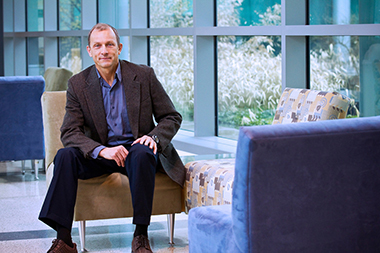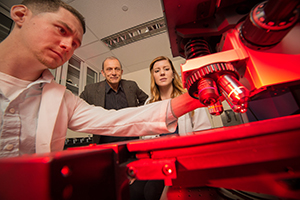Forensic Chemist Can Now Predict Age of Bloodstains Up to 2 Years
 |
|
Igor Lednev, chemistry professor. (Photo by Paul Miller) |
ALBANY, N.Y. (June 13, 2017) – Igor Lednev is adding yet another capability to his patented laser technology that could soon help law enforcement catch criminals.
Lednev, a chemistry professor at the University at Albany, along with graduate student Kyle Doty, released findings this month on a method to accurately predict the age of bloodstains at crime scenes for up to two years. Results were published in Forensic Chemistry.
The method relies on Raman spectroscopy and advanced statistics.
Raman spectroscopy is a technology that measures the intensity of scattered light by shining lasers on a sample. Since no two compounds produce the same exact Raman spectrum, the measurements are unique, almost like a fingerprint. The process is also nondestructive, allowing for the preservation of the material for subsequent DNA analysis.
Lednev’s lab collected fresh blood two years ago from two healthy adults (one male and one female). The dry samples were analyzed at 15 different time points in the lab – from one hour to two years. An overall success rate of 70 percent was demonstrated in predicting the bloodstain’s age up to two years. The method can distinguish the stain by hours, days, weeks, months or years.
There’s currently no single validated approach being used by forensic practitioners to determine the time-since-deposition of bloodstains.
“Determining the time at which a crime occurred and the order of events of the crime scene can be challenging, especially if no reliable witnesses are available,” Lednev said. “Blood is the most common body fluid found at the scene of a violent crime, and can be the most valuable in the amount and types of information it can provide.”
 |
|
Igor Lednev works with graduate researchers Claire Muro and Kyle Doty on his lab's multidimensional Raman spectroscopy project. (Photo by Paul Miller)
|
Lednev’s findings are the latest in his lab’s multidimensional Raman spectroscopy project. The team, led by several graduate researchers including Doty, Claire Muro, Ewelina Mistek and Marisia Fikiet, is also using lasers to preform microscopic analyses on saliva, semen, sweat and vaginal fluid.
Their goal is to develop a “point-and-shoot” Raman spectroscopy instrument that can be used by law enforcement to analyze crime scene biological stains. Information that could be obtained from the instrument includes the type of body fluid, if the sample is human or animal in origin, estimated time-since-deposition, and key suspect or victim characteristics such as sex, race and age.
Lednev believes a handheld Raman instrument could be commercialized within three to five years.
“We are demonstrating the ability for law enforcement to obtain key information and specific characteristics (age, race, sex, etc.) by simply scanning a biological stain at the crime scene,” Lednev said. “Our tool would significantly narrow down the search for a suspect or victim.”
Lednev’s laboratory has been funded by the National Institute of Justice (NIJ) for eight consecutive years for a total of about $2.2 million. He’s also received a separate NIJ grant to analyze gunshot residue through Raman spectroscopy, and investment from SUNY’s Research Foundation Technology Accelerator Fund. His team has published over 50 articles in peer-reviewed journals over the past decade and received several patents.
You can learn more about Lednev by visiting his personal website or his official University expert page.
![]() For more news, subscribe to UAlbany's RSS headline feeds
For more news, subscribe to UAlbany's RSS headline feeds
A comprehensive public research university, the University at Albany-SUNY offers more than 120 undergraduate majors and minors and 125 master's, doctoral and graduate certificate programs. UAlbany is a leader among all New York State colleges and universities in such diverse fields as atmospheric and environmental sciences, business, education, public health,health sciences, criminal justice, emergency preparedness, engineering and applied sciences, informatics, public administration, social welfare and sociology, taught by an extensive roster of faculty experts. It also offers expanded academic and research opportunities for students through an affiliation with Albany Law School. With a curriculum enhanced by 600 study-abroad opportunities, UAlbany launches great careers.


